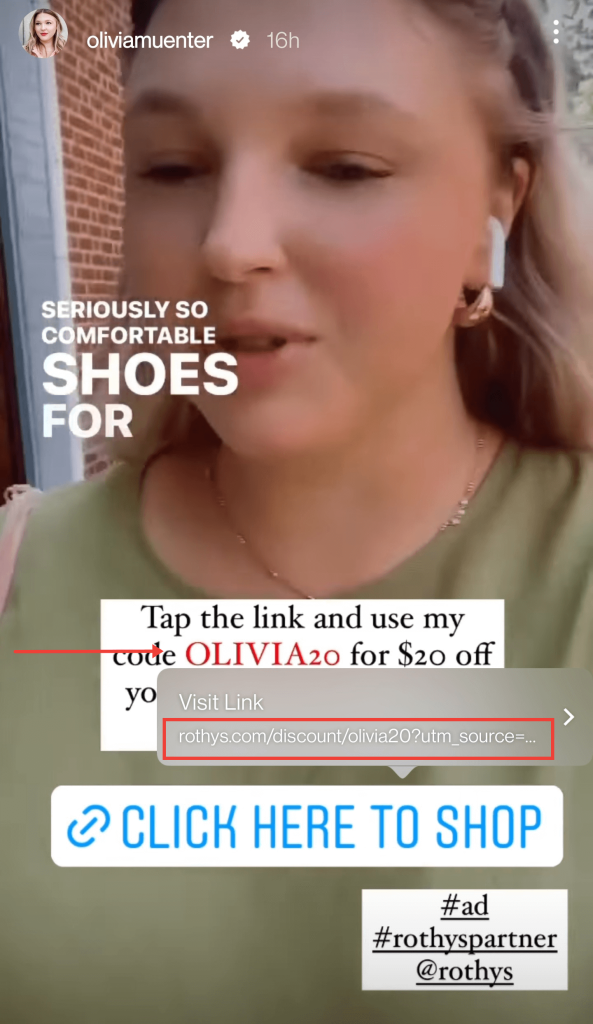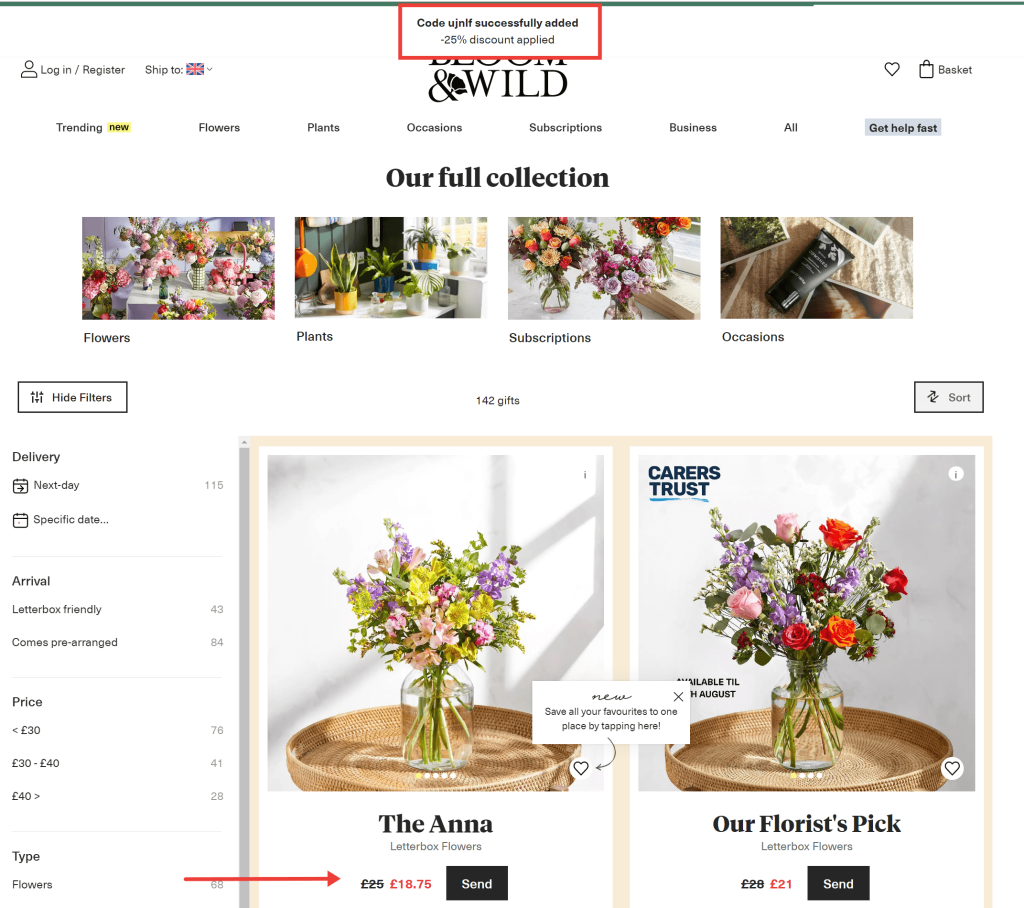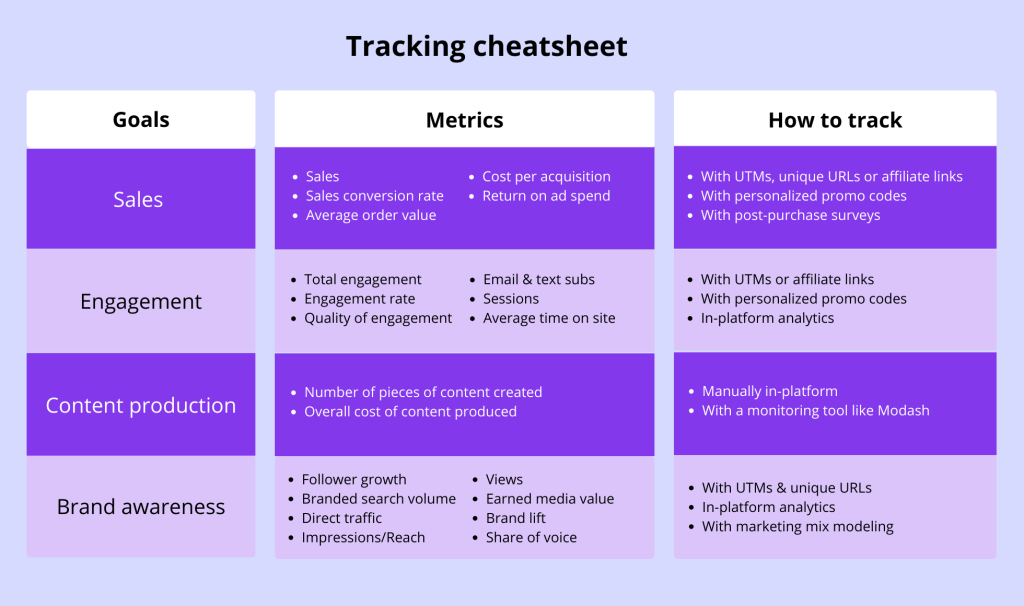How to Measure Influencer Marketing Campaigns: 8 Tracking Methods
- •Measuring the Impact of Influencer Marketing: A Comprehensive Guide
- •8 Effective Strategies for Monitoring Influencer Marketing Campaigns
- •1. Implementing Personalized Promo Codes
- •2. Leveraging UTMs for Session and Sales Tracking
- •3. Using Monitoring Tools for Content Tracking
- •4. Accessing Influencers’ In-Platform Analytics
- •5. Creating Unique Landing Pages
- •6. Implementing Affiliate Programs and Links
- •7. Conducting Surveys for Indirect Attribution
- •8. Applying Marketing Mix Modeling
- •The Crucial Role of Goal Setting in Measuring Influencer Marketing
- •Alignment with Business Goals
- •Metrics for Sales Goals
- •Metrics for Engagement Goals
- •Metrics for Content Production Goals
- •Metrics for Brand Awareness Goals
- •Structuring Your Influencer Marketing Measurement Workflow
Measuring the Impact of Influencer Marketing: A Comprehensive Guide
Imagine this scenario:
On a Friday evening, Fred is leisurely browsing TikTok when he stumbles upon a video of a popular influencer enjoying a dip in an inflatable pool. He watches, chuckles, and scrolls past.
Come Sunday, with the mercury rising, Fred recalls that TikTok video and decides to Google the brand. His search reveals that the pool is available at a nearby retail outlet, just a stone’s throw from his workplace.
A week later, we see Fred leaving the store, a brightly colored box under his arm, containing the very pool he saw on TikTok.
Simultaneously, a social media strategist at Blow-Up Pool Inc. is pondering a question from the Marketing Director, posed in a Slack message:
“Katie, does influencer marketing really justify our budget and time?”
This guide aims to equip Katie and all the other marketing professionals grappling with demonstrating the value of influencer marketing. It’s especially for those who recognize the limitations of traditional tracking methods on social platforms and understand that metrics like likes, comments, and views don’t always translate to financial success.
What’s the best course of action?
We find wisdom in Marcus Burke’s approach, a veteran of influencer marketing at Blinkist and Tandem, among others.
Marcus advises: “Just start. Begin with a couple of tracking methods, pick a handful of influencers, and get going. It’s only through experience that you’ll refine your tracking techniques and gain confidence in this channel.”
This guide will delve into 8 effective strategies to track influencer marketing, underscore the necessity of goal setting, and
explore which Key Performance Indicators (KPIs) might be most suitable for your campaign.
Before we dive into that, let’s discuss the insights we’ve gained from over 34 hours of research, conversations with experts, and 3+ years of collaborating with brands.
Key Insights on Measuring Influencer Marketing
- Just Begin: Start with one or two tracking methods, engage 10-20 influencers, and initiate your campaign. Practical experience is crucial for discovering more effective tracking methods given your resources.
- Full-Funnel Potential: Influencer marketing isn’t just about raising brand awareness; it’s a versatile tool. It can enhance sales, increase engagement, boost content production, reach new demographics, and elevate brand visibility. Neglecting its full potential could mean missing out on significant revenue opportunities.
- Long-Tail Strategy: Similar to SEO and content marketing, the real impact of influencer marketing emerges over time. Immediate results are rare, and patience is key to observing its true value.
- Establish Benchmarks: Use historical data from tools like Google Analytics or your eCommerce platform for context. Compare your influencer marketing results with other channels. Relying solely on external industry benchmarks can be misleading.
- Synergistic Effects: Influencer marketing doesn’t operate in isolation. It can bolster and be bolstered by other marketing channels, whether paid, earned, or owned. Coordinating strategies across channels can yield enhanced outcomes.
- The 25% Rule: Only about a quarter of purchases are traceable via attributable links. For teams aiming for rapid progress, focusing on execution might be more beneficial than striving for perfect measurement.
Note: This guide specifically addresses digital marketing strategies for eCommerce and consumer mobile applications, acknowledging that traditional marketing channels like print, TV, and radio can influence eCommerce, and digital marketing can drive in-store sales.
In conclusion, influencer marketing is a dynamic and evolving field. It requires a blend of strategic planning, patience, and adaptability. By starting small, setting clear goals, and gradually refining your approach based on real-world data, you can unlock the full potential of influencer marketing and make informed decisions that align with your brand’s objectives and resources. Remember, the Find Me Creators Database is an invaluable resource, offering a comprehensive database of TikTok micro/nano influencers and UGC creators, providing the data and contacts necessary to launch and measure effective influencer campaigns.
8 Effective Strategies for Monitoring Influencer Marketing Campaigns
Mastering the art of tracking influencer campaigns can range from straightforward to complex, depending on your needs and resources. Here’s a detailed guide to help you choose the best method for your campaign.
1. Implementing Personalized Promo Codes
Ideal for: Simple sales tracking and audience incentives
The use of personalized promo codes is a straightforward yet effective method. These codes, unique to each influencer, allow you to monitor sales and other direct and indirect outcomes.For instance, in a collaboration with writer Olivia Muenter, Rothys used the promo code “OLIVIA20”. This approach is not only simple but memorable.Promo codes let you track various sales metrics, including total sales, average order value, and more.In Summary: Promo codes are a fast and efficient way to start tracking influencer campaigns.

2. Leveraging UTMs for Session and Sales Tracking
Ideal for: Comprehensive tracking of sessions and sales
UTMs (Urchin Tracking Modules) are vital for detailed tracking. These small text additions to URLs provide in-depth insights into traffic sources and user behavior.For example, Rothys combined a promo code with a UTM link.
UTMs can tell you the source, medium, campaign, and content of traffic. To make UTMs more user-friendly, consider using a URL shortener like Bit.ly for easy recall and tracking.
UTMs enable various analyses, such as comparing sales across influencers, assessing campaign types, and evaluating content performance.
In Summary: UTMs, combined with tools like Bit.ly, offer a detailed and manageable way to track influencer contributions.

3. Using Monitoring Tools for Content Tracking
Ideal for: Large-scale, automated tracking of sponsored content
Monitoring every sponsored post manually is time-consuming. This is where monitoring tools come in. These tools automatically track posts, compliance with brand guidelines, hashtag usage, and engagement metrics.
In Summary: Automated monitoring tools save time and
provide comprehensive insights into your campaign’s performance.
4. Accessing Influencers’ In-Platform Analytics
Ideal for: Detailed engagement data for individual posts
Directly requesting influencers for post metrics is crucial, especially for brand awareness goals. This includes data on views, impressions, reach, and engagement.
However, remember these metrics represent a snapshot in time and may evolve.Including reporting expectations in your influencer contracts can streamline this process.
5. Creating Unique Landing Pages
Ideal for: Sophisticated tracking of traffic and engagement
Unique landing pages offer a more personalized user experience and precise tracking capabilities. These pages can be tailored to individual influencers or campaigns and can be set to no-index to ensure all traffic is directly from the influencer’s link.
Examples like Magic Spoon’s personalized landing page for podcast listeners showcase the effectiveness of this approach.
In Summary: Unique landing pages enable precise tracking and offer a personalized experience to users.

6. Implementing Affiliate Programs and Links
Ideal for: Scalable influencer programs with performance-based models
Affiliate programs are not just payment models but also effective tracking tools. They provide insights into leads, clicks, installs, and sales. Once set up, each influencer gets a unique link, simplifying long-term tracking.
In Summary: Affiliate links are a powerful tool for both tracking and incentivizing influencers in a scalable way.

7. Conducting Surveys for Indirect Attribution
Ideal for: Capturing indirect influences on consumer decisions
Surveys, particularly post-purchase, can help understand how customers discovered your brand. Make surveys specific by including influencer names or handles. Timing the survey appropriately can also improve user experience and response accuracy.
In Summary: Surveys are a valuable method to capture the indirect impact of influencer marketing.
8. Applying Marketing Mix Modeling
Ideal for: Comprehensive, aggregate-level performance analysis
Marketing Mix Modeling (MMM) is a sophisticated approach that evaluates the contribution of each marketing element, including influencer campaigns. It’s particularly useful in the current landscape where user-level tracking faces challenges.
MMM can be resource-intensive but is valuable for understanding the full impact of a campaign, including indirect effects. It’s best suited for larger teams with significant marketing budgets.
The technique involves statistical analysis to attribute success to various factors, both trackable and untrackable. For smaller teams, this might not be cost-effective, but it’s worth considering for larger, more complex campaigns.
In Summary: Marketing Mix Modeling offers a comprehensive view of your marketing efforts, including the nuanced impact of influencer marketing, though it requires significant investment in time and resources.
In conclusion, tracking the efficacy of influencer marketing campaigns is essential for understanding their return on investment and guiding future strategies. From simple promo codes to sophisticated marketing mix modeling, there are various methods to suit different needs and budgets.
By selecting the right combination of these methods, you can gain a comprehensive view of your influencer marketing campaigns’ performance. Remember, tools like the Find Me Creators Database can provide additional insights and data, especially when working with micro and nano influencers on platforms like TikTok, enhancing your overall influencer marketing strategy.
The Crucial Role of Goal Setting in Measuring Influencer Marketing
Understanding the importance of goal setting in influencer marketing is crucial for any successful campaign. Without clear goals, measuring the impact of your influencer marketing efforts becomes a shot in the dark. Here’s why establishing goals is a step you can’t afford to skip:
- Guiding Influencer and Content Choices Every decision, from selecting the right influencers to determining the content they create, hinges on your goals. This alignment ensures that every aspect of your influencer campaign is tailored to meet your objectives.
- Determining Appropriate Tracking Methods The metrics and methods you use for tracking should directly correspond to your goals. This ensures that you
are collecting relevant data that truly reflects the success of your campaign in relation to your objectives.

Alignment with Business Goals
It’s essential that your influencer marketing goals don’t exist in isolation but align seamlessly with your broader business objectives. This ensures coherence in your marketing strategy and contributes meaningfully to your business’s overall success.
Examples of Influencer Marketing Goals:
- For Content Production: “Generate [X number] of posts and repurpose [Y number] of posts for [specific channel(s)] in Q2.”
- For Sales: “Achieve a sales increase from [X to Y] through [specific channel] in Q3.”
Now, let’s break down what metrics to track, categorized by these specific goals:
Metrics for Sales Goals
Setting sales goals is
crucial, even for those new to influencer marketing. Avery Schrader, CEO of Modash, notes that most companies see a measurable impact on sales with their first influencer partnerships. Key metrics for sales goals include:
- Number of Sales: Track the total sales generated directly from influencer campaigns.
- Sales Conversion Rate: Measure how effectively influencer-generated traffic converts into sales.
- Average Order Value (AOV): Determine the average spending per order originating from influencer campaigns.
- Promo Code Redemptions: Monitor the use of influencer-specific promo codes.
- Cost per Acquisition (CPA): Calculate the cost incurred for each customer acquired through influencer efforts.
- Return on Ad Spend (ROAS): Assess the revenue generated for every dollar spent on influencer marketing.
Metrics for Engagement Goals
Engagement is indicative of interest or intent. Relevant metrics include:
- Adds to Cart: Number of products added to cart from influencer referrals.
- Account Creations and Wishlist Additions: Monitor accounts or wishlists created as a result of influencer marketing.
- Email or Text Subscribers: Growth in subscribers attributable to influencers.
- Sessions and Average Time on Page: Track website engagement metrics.
- Cost per Conversion and Engagement Rate: Evaluate the cost-effectiveness and level of engagement.
- Quality of Engagement: Assess the depth and relevance of interactions.
Metrics for Content Production Goals
For many, increasing the quantity and quality of content through influencers is a primary goal. Metrics to consider:
- Number of Content Pieces Created: Count all pieces of content generated by influencers.
- Overall Cost of Content Produced: Assess the cost-effectiveness of content production through influencers.
Metrics for Brand Awareness Goals
Brand awareness is a top priority for many marketers. Metrics to monitor include:
- Follower Growth on Brand’s Social Accounts: Measure the increase in followers as a result of influencer campaigns.
- Branded Search Volume and Direct Traffic: Track increases in brand-related searches and direct website visits.
- Impressions, Reach, and Views: Evaluate the extent of exposure generated by influencers.
- Earned Media Value: Estimate the value of exposure gained through influencer marketing.
- Brand Lift and Share of Voice: Assess the overall impact on brand perception and comparative market presence.
In conclusion, setting specific, aligned goals for your influencer marketing campaigns is essential. By understanding and tracking the right metrics, you can effectively measure the impact of your campaigns and make informed decisions to optimize future strategies.
Structuring Your Influencer Marketing Measurement Workflow
Creating an effective measurement workflow for your influencer marketing campaigns is essential for tracking progress and evaluating success. While there is no one-size-fits-all approach, organizing your workflow depends on various factors, including campaign goals, duration, team size, and available resources. Here’s a guide to help you structure your workflow effectively:
1. Daily/Weekly Tracking Tasks
- Monitor Content Regularly: Choose specific days and times to review content posted by influencers. This ensures active engagement and timely responses.
- Track Directly Attributable Goals: Regularly check metrics like UTM clicks, promo code redemptions, and affiliate sales. This helps in monitoring immediate impacts.
- Engagement with Content: Schedule time to actively engage with the content posted by influencers. This not only boosts visibility but also builds relationships.
2. Monthly/Quarterly Tracking Tasks
- Frequency of Reporting: Discuss with your team and stakeholders to establish how often you should report on the campaign’s progress.
- ROI Calculations: Decide on specific dates for calculating total ROI, considering both direct and indirect results.
- Track Influencer Performance: Regularly assess which influencers are performing well and which are not. This helps in making decisions about future collaborations.
3. Calculating and Reporting ROI
- Direct ROI Reporting: This involves calculating the standard ROI, answering what the goal was, whether it was achieved, and at what cost. Be sure to include the business objective, campaign details, and achieved results in your report.
- Indirect ROI Reporting: Don’t overlook the ‘intangible’ benefits, such as new impressions, value of influencer-generated content, indirect traffic growth, follower growth on social channels, and the development of new relationships.
4. Lessons Learned and Forward Planning
- Regularly assess what worked and what didn’t in your campaigns.
- Identify best-performing influencers and content, and look for patterns or insights that can be applied to future campaigns.
- Share findings with stakeholders and use these insights for continuous improvement.

Key Takeaways:
- Flexibility in Tracking: Remember that there’s no perfect tracking system. Aim to use the tools and resources you have effectively.
- Simplicity vs. Complexity: Tracking can range from basic methods like promo codes to complex data analysis, depending on your needs and capabilities.
- Underestimation of Influencer Marketing: Recognize the potential of influencer marketing. Start with what you can manage and grow your strategy over time.
In summary, organizing your influencer marketing measurement workflow involves regular monitoring, strategic reporting, thoughtful analysis, and continuous learning. By adapting these practices to your specific campaign needs and goals, you can effectively measure and maximize the impact of your influencer marketing efforts.